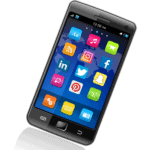Table of Contents
*This post may contain affiliate links. As an Amazon Associate we earn from qualifying purchases.
The habit forming mobile device is your new loyalty card. By taking full advantage of our mobile phone addiction, marketers are launching easy to access loyalty programs in record numbers.
Forget those customer loyalty cards of the past, the mobile driven loyalty card app is by far the best way to attract customers and manage relationships.
In a universe where we all expect to have everything we need at our fingertips, easy access and omnichannel compatibility is becoming the only way to go.
In fact, Millennial customers prefer using their mobile devices and social media to participate in loyalty programs.
Mobile Is A National Addiction

As a nation, Americans check our mobile phones more than 8 Billion times per day.
According to a recent Deloitte study, this number has increased to a record breaking, all-time high.
The reason, we are making more financial transactions and everyday purchases using mobile, than ever before. Familiar mobile pay apps have been supplemented with easy tap and pay services.
Technology, personalization, product availability and convenience are creating new purchase habits. These conditions have come together to form the perfect scenario for launching a mobile driven loyalty program.
Why We Enjoy Mobile Addiction

Our human need for pattern recognition, combined with some emotional stimulation thrown in, makes us return to the easy to use and familiar.
When ordering a pizza, or making an online purchase of any kind, becomes repetitive, the process becomes a habit.
The added incentive driven by an SMS discount, and/or the opportunity to earn free stuff, provides the emotional kick in the brain to create brand loyalty.
A real-time example is the fact that today over fifty percent of US households are Amazon Prime members. Because of this it’s estimated that 55% of all online shoppers, in the US, check Amazon first when they shop.
Hut Rewards Invests $5 Million in Super Bowl Ad
Ordering Pizza is as much a part or the American Experience as watching the Super Bowl. Brand loyalty to a particular Pizza restaurant is based on many factors, including the overall brand experience.
Betting on the consumer’s need for ease-of-use, along with what they may already know about the brand’s products, Pizza Hut went for broke. Shelling out a lot of dough, they introduced their Hut Rewards loyalty program to 103 million Super Bowl viewers.
To make an emotional connection with Football fans, Hut Rewards featured former Dallas Cowboy wide receiver Terrell Owens as their ‘professional boaster’ (their title).
On behalf of the family enjoying their free Hut Rewards pizza, he boasted about how fast we can earn free pizza because “no one out pizzas the Hut.” Nothing was mentioned about taste, service, social programs or other brand attributes. Nope, just the fact that you earn free pizza fast.
I went to the Hut Rewards site and saw that the online only program offers: unlimited points, exclusive offers, birthday rewards, and faster checkout.
By migrating customers to Mobile/Online ordering, Pizza Hut is able to:
- Provide a more efficient order process
- Make it easy to interact on a mobile device
- Send offers through SMS or online
- Collect valuable data about their customer’s preferences.
The birthday rewards benefit indicates that they are personalizing the program to create a relationship with the individual customer.
I present the Hut Rewards example simply as a case study, due to their huge investment in Super Bowl airtime.
The point is that in today’s mobile connected world, brands that want to attract the Millennial and Generation Z’s business, had better be thinking about using mobile and social media to create an easy way to interact, sell and build customer relationship.
Brand message has become secondary when it’s about ease and convenience. Of course, you had better spent time building some type of brand essence and come through with a great product that is delivered fast.
Technology and Social Science Loyalty Drivers
Not to sound too futuristic or scientific, but, creating brand habits requires a combination of
- Emotional stimulation
- Brand memory (from previous campaigns and experiences)
- Pattern recognition
Facebook has proven that getting people to pause, stop and think as one scrolls through their Facebook feed is a science.

Recently Facebook changed the way they send information to users because the former strategy was ‘undermining affective well-being’, according to a Journal of Psychology study.
As humans, we are easily sucked-in to the fascinating visual mobile medium that creates these addictive behaviors.
Our data is collected to identify customer preferences. Personalized offers and messages are then developed to keep us hooked. Data is also analyzed to create look-alike models to identify new customers. Sounds terrible, but in our busy world we seem to embrace it as consumers.
The biggest complaints people have with loyalty programs are that they are confusing and not centralized in one place for the consumer to access.
Originally, Google wallet loyalty card program was among the first to launch a receptacle for many loyalty accounts. Like all pioneer programs it has since changed. However, many wallet apps are now available to store and access loyalty programs.
Blockchain Technology May Be The New Loyalty Model
[amazon fields=”1981522026″ value=”thumb” image_size=”large” image_align=”center”]
[amazon fields=”1981522026″ value=”button”]
With increased mobile access, enrollment into merchant loyalty programs has increased by twenty-five percent. While this increase is significant, it’s important to note that only forty-five percent of members actually use their loyalty programs.
Even with a wallet app, the cards and numbers are all over the place. We only tend to use the programs that have ease-of-use for the brands that appeal to us.

The Deloitte Center for Financial Services has developed a very compelling in-depth study showing how blockchain technology could be the new, cost-effective alternative for managing loyalty programs.
Until now, most of us relate blockchain technology to cryptocurrency such as bitcoin.
[amazon fields=”1491954388″ value=”thumb” image_size=”large” image_align=”center”]
[amazon fields=”1491954388″ value=”button”]
However, when we take the same concept of sharing loyalty data in one interlinked loyalty network, the study shows how it may increase involvement, loyalty and cost-savings among all participants.
Merchants, Customers and Administrators alike could interact with each other real-time, and create new cooperative efforts the likes we haven’t yet imagined.
The fragmentation and confusion of working with different loyalty programs has been a major pain point to the consumer.
On the merchant side, this confusion and fragmentation had been a way to reduce redemption and liability. Consumers are on to this and are abandoning programs that are difficult to earn and redeem rewards.
To address the merchant liability issue the Deloitte study makes the following point:
For loyalty rewards program providers, we believe that blockchain has the potential to streamline execution and administration of their programs with near-real-time transparency, resulting in cost savings that can be realized in the medium term. For loyalty rewards programs that currently have competitive advantage through scale, including their own degree of interlinking networks, we still believe that joining a blockchain-based network is a trade-off worth making given that they may join on their own terms, controlling how they wish their customers to interact with their rewards programs and others.
Loyalty Is About A New Relationship Paradigm
With the growth of social media there has been a paradigm shift. In the past, brands controlled the narrative and had the belief that they owned the customer relationship.
As consumers become more connected with brands, and each other, through social media there is more of a shared relationship approach to marketing.
Loyalty programs that are easy to access, redeem and make the customer the center of attention, through applied data analysis and personalization are succeeding. As Millennials and Generation Z come into the loyalty arena, easy and seamless is the strategy to consider.
[amazon fields=”1979414718″ value=”thumb” image_size=”large” image_align=”center”]
[amazon fields=”1979414718″ value=”button”]

